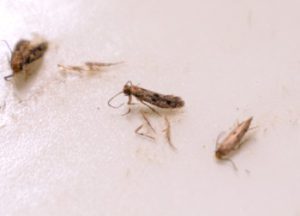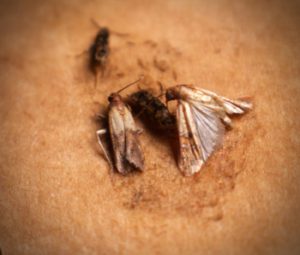CLOTHES MOTHS? OR, SCAVENGER HOUSE MOTHS?
By Chris Williams on October 23, 2019.
At this time of year, we get more calls than usual about tiny little moths flitting around the house – presumably because people are taking winter clothes out of storage and are either seeing clothes moths or are worried about seeing clothes moths.
Not all small moths are clothes moths. Food moths can be similar in size or only slightly bigger than clothes moths. Like clothes moths, they can also be more noticeable in homes at this time of year when people have large bags of infested bird seed stored in the pantry, garage, or basement. Food moths also very commonly infest large bags of dry pet food, especially when stored in damp places. See Clothes Moths or Pantry Moths?
There’s still a third group of small moths that can show up in homes. These are scavenger moths. Some are called clothing or tapestry moths, although fabrics may be infested only rarely. Most of these little moths will also feed on stored foods and will scavenge on other miscellaneous sources of protein or keratin such as dead insects, feathers or hair in animal nests, or trophy mounts on the wall. One species even feeds on spider webs. These moths are not common and usually don’t build up to numbers that would cause significant damage – unlike the real clothes moths.
ARE BROWN HOUSE MOTHS IN YOUR FUTURE?

Three Brown House Moths. Z. Ciras
One of these scavenger moths that we are seeing pretty regularly in homes is the brown house moth, Hofmannophila pseudospretella. This moth is also called the “false clothes moth” although it is broader and darker than either the webbing clothes moth or the casemaking clothes moth. These two clothes moths are quite small (1/4 to 1/3-inch long with folded wings) and are satiny beige in color.
Besides size, another way to tell clothes moths from either the household food moths or scavenger moths is that clothes moths are light-colored with virtually no markings on their wings and with a fringe of golden hairs at the edge of the wing. Most all of the other household pest moths are light brown or gray with some pattern of dark spots or markings on their wings. The brown house moth, for example, is bronze-brown in color with dark brown flecks on the wings and is just under 1/3-inch long.
Let’s hope that brown house moths never really establish themselves as household pests in our region because they are able to feed on so many different foods; one of their primary foods is cereal products. They’ve been found feeding on feathers in birds’ nests and on cloth and leather bindings of books. They’ll feed on dead insects, macaroni, or woolens. Under the right conditions, they can reportedly be more destructive to fabrics than the webbing clothes moth. These humidity-loving moths are major pests in warehouses in the United Kingdom and it has been said that you would be hard-pressed to find a home in Britain without at least a few brown house moths.
IF IT’S FLYING TO LIGHTS, IT’S NOT A CLOTHES MOTH!

Indian Meal Moths with Brown House Moths on a monitor. Z. Ciras
Here’s an inspection tip courtesy of Colonial Pest that might put your mind at ease if you’re worried that your home is infested with clothes moths. If you’re seeing little moths flitting around at night, flying in front of the TV or near lights, they are not clothes moths. Unlike almost all other moths, clothes moths shun light. They remain hidden in dark places and avoid light. Now, if you are seeing little moths in the dark recesses of your closet, you should be concerned. And, those TV-attracted moths could be Indianmeal moths.